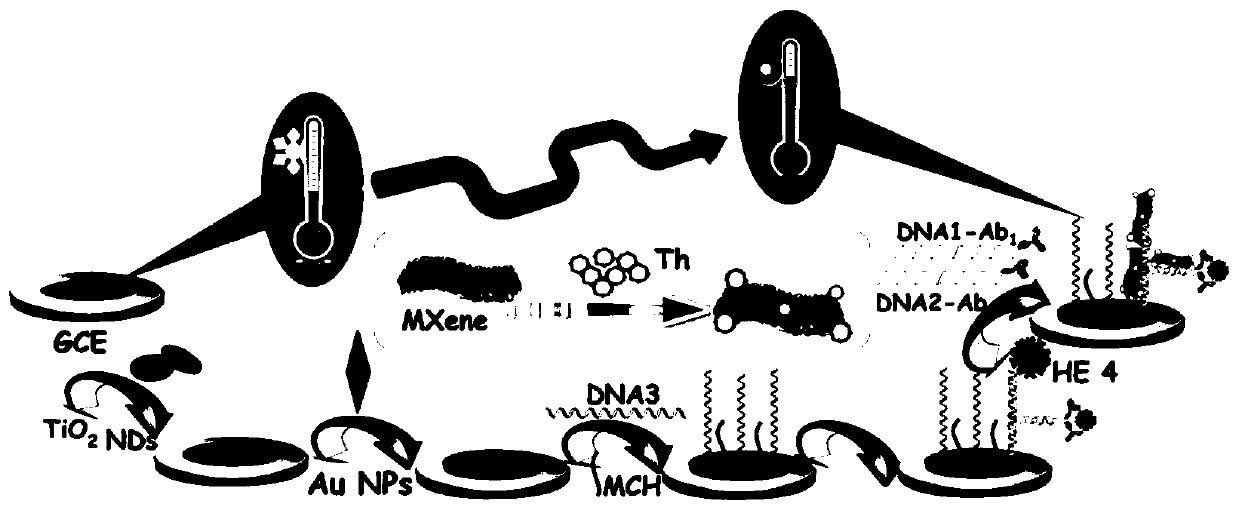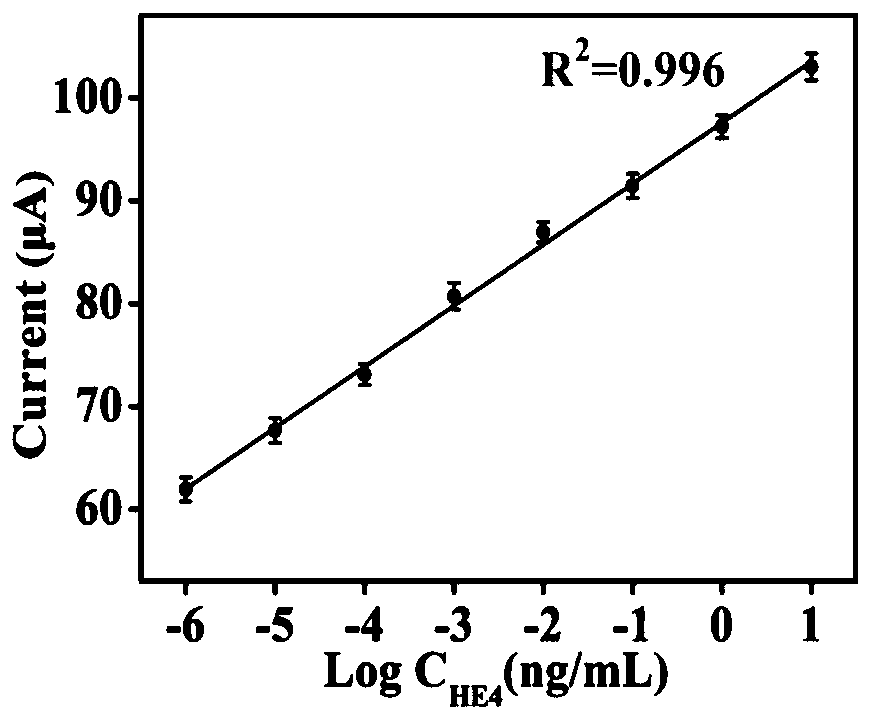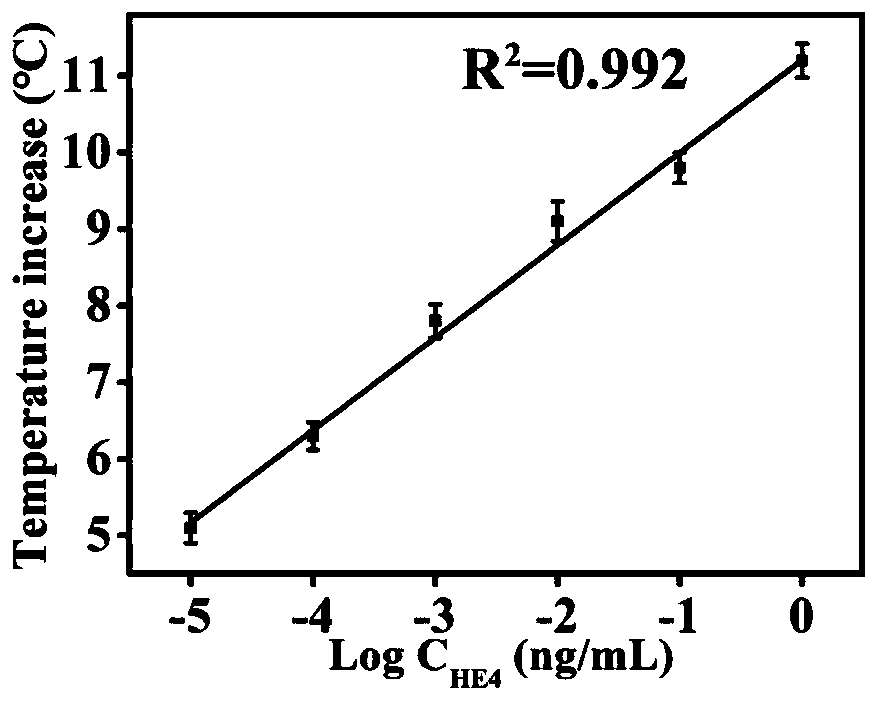Preparation and application of adjacent hybridization dual-mode immunosensor based on MXene nanosheet photo-thermal amplification
An immunosensor and nanosheet technology, which can be applied to anti-peptide structure protease inhibitor immunoglobulins, instruments, scientific instruments, etc., and can solve the problems of limited application of instrument analysis technology.
- Summary
- Abstract
- Description
- Claims
- Application Information
AI Technical Summary
Problems solved by technology
Method used
Image
Examples
Embodiment 1
[0026] Fabrication of a proximity hybridization dual-mode immunosensor based on photothermal amplification of MXene nanosheets (e.g. figure 1 shown):
[0027] (1) Pretreatment of the glassy carbon electrode: the glassy carbon electrode is first mechanically polished and polished on the suede covered with alumina powder, washed with secondary water to remove the residual powder on the surface, and then moved into an ultrasonic water bath for cleaning until it is cleaned, and finally Wash thoroughly with ethanol, dilute acid and water;
[0028] (2) Add 3 mg of TiO 2 Discoid nanoparticles (TiO 2 NDs) powder was dissolved in 1 mL ultrapure water to obtain 3 mg / mLTiO 2 For the aqueous dispersion of NDs, take 10 µL polyethyleneimine (PEI) and dilute it with ultrapure water to 1 mL to obtain a 1 wt.% PEI aqueous solution, and add 1 mL of the above TiO 2 Add 1 mL of 1 wt.% PEI aqueous solution to the NDs dispersion, stir continuously at room temperature for 6 h, centrifuge at 1...
Embodiment 2
[0034] TiO used in embodiment 1 2 Discoid nanoparticles (TiO 2 NDs) Preparation:
[0035] Mix 4.5 g terephthalic acid, 2.34 mL butyl(IV) titanate, 9 mL anhydrous methanol, and 81 mL N,N-dimethylformamide (DMF), then transfer the mixture to a 100 mL autoclave , heated at 150 °C for 48 h, filtered after cooling and washed with methanol several times to obtain a white suspension, subsequently, the above-mentioned white suspension product was calcined in air at 400 °C for 5 h, after natural cooling, the white powder obtained was collected as TiO 2 Discoid nanoparticles (TiO 2 NDs);
[0036] The DNA used in Example 1 1 -Ab 1 or DNA 2 -Ab 2 Preparation of:
[0037] Antibody (Ab 1 or Ab 2 ) activation: take 0.2 mg antibody (Ab 1 or Ab 2 ) solid was diluted to 0.2 mg / mL with 1 mL of 55 mM, pH 7.4 phosphate buffer solution, and 10 µL of 0.4 mM (N-maleimidomethyl)cyclohexane-1-carboxylate succinyl Dimethyl sulfoxide solution of imidate (SMCC), mixed with 100 µL of 0.2 mg...
Embodiment 3
[0041] An application of a proximity hybridization dual-mode immunosensor based on photothermal amplification of MXene nanosheets, the steps are as follows:
[0042] (1) The three-electrode system was used for measurement, and TiO 2 NDs-PEI / DNA 3 / DNA 1 -Ab 1 -HE4-DNA 2 -Ab 2 The / MXene@Thi modified electrode was used as the working electrode, Ag / AgCl was used as the reference electrode, and the platinum wire electrode was used as the auxiliary electrode. HE4 was detected on the electrochemical workstation, and the initial potential was set to 0 V, and the termination potential was set to -0.5 V;
[0043] (2) In a phosphate buffer solution of pH 7.4, square wave voltammetry (SWV) was used to measure 1×10 -6 ng / mL~10 ng / mL series of HE4 standard solutions with different concentrations were used to measure the electrochemical behavior on the modified electrode. By recording the electrochemical signal generated after 808 nm laser irradiation, the working curve was drawn, s...
PUM
 Login to View More
Login to View More Abstract
Description
Claims
Application Information
 Login to View More
Login to View More - R&D
- Intellectual Property
- Life Sciences
- Materials
- Tech Scout
- Unparalleled Data Quality
- Higher Quality Content
- 60% Fewer Hallucinations
Browse by: Latest US Patents, China's latest patents, Technical Efficacy Thesaurus, Application Domain, Technology Topic, Popular Technical Reports.
© 2025 PatSnap. All rights reserved.Legal|Privacy policy|Modern Slavery Act Transparency Statement|Sitemap|About US| Contact US: help@patsnap.com



